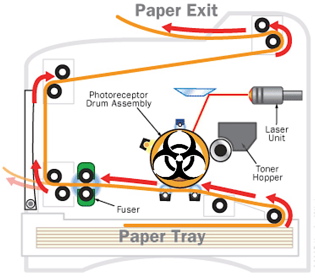
That laser printer sitting on your desk could be emitting high levels of potentially hazardous particles. Some printers release almost as many ultra-fine particles as a smoldering cigarette, the study authors said.
There have been few studies on the health hazards of printing, and the current research, appearing in the journal Environmental Science and Technology, provides the most extensive look yet at particle emissions of office printers, including Canon, Hewlett-Packard, Ricoh and Toshiba models.
Lidia Morawska and her colleagues classified 37 printers as non-emitters, eight as medium or low emitters, and 17 as high emitters.
Among the machines that had no emissions were eight HP LaserJet 4050 series printers and four Ricoh Aficio models. High emitters included the HP LaserJet 1320 and 4250, which, when printing, increased the particle number in the air more than tenfold.
The kicker is that – Morawska did not set out to study printers. She was measuring office air quality – and when and where pollution increased led her to the laser printers.















I’m a tech for and office and I had a lady complain about this very thing 4 months ago when a guy was fixing a printer. I told her she would be fine after the dust settled. I have never seen it “poof” out after a job was done.
Fascinating find! I smell lawsuits…
Here’s the list.
http://tinyurl.com/24uqfp
#3 – thanks. Till yesterday, it was only PPV.
Offices buy lasers to reduce costs. 600 dpi is sufficient.
If only someone built 600 dpi inkjet printers designed from the start with 16oz cheap, reusable, containers for each RGB+black, and a built in NIC.
Could it also be because laser printers have become noticeably “cheaper” in quality construction, to reduce price, in the last 10 years?
I paid 399$ Cnd last year a HP2600N color laser 600 dpi, to replace the Lexmark X75 all-in-one (250$) bought in 2000.
The Lexmark is now a dust collector, despite is much higher DPI.
I won’t have a printer at home. The money for a printer is not a lot but it’s money and I have access to much better printers at school or the cyber cafe down the street.
I work in a digital print production facility, with a room full of Laser printers running 24/7 are these things killing me?
#7. Yes, while I would need more information to really tell you how much time you have left. But if I carry the one, your workplace printers probably shaved 5 maybe 7 minutes off your life.
This “spraying of toner” is nothing new. All copiers use the same toner as laser printers and have since the first Xerox copier was sold. So, while one might wish that such particulate not be circulating in the air it has gone on for decades. The lowly copier found everywhere is just a dangerous as the modern laser printer.
If there is a correlation between particulates and pulmonary disease, then I would expect them to find statistically significant numbers relating copier repair people and copy shop employees to a history of pulmonary diseases. Find this link, and then maybe I’ll worry.
Rob Goodfellow states the office copier is just as dangerous. Actually, this same study found zero ultra-fine particulate emissions from the office copiers, while some of the laser printers had counts higher than that collected next to busy roadways.
This issue is not just particulates. It’s the size of the particulates. Ultra-fine particulates (the type measured from the laser printer emissions) have the potential to cause more lung damage because they get deeper into the lung and because other harmful or toxic things can “piggyback’ on those particles as a means of gaining entry deep into the pulmonary tissue. It’s also a concern for home users with children. In children under age 12, the lungs are still developing, and ultra-fine particulates can cause damage that will manifest later in life with increased risk of asthma and some of the other pulmonary diseases that fall under the realm of COPD. (This I can attest to from personal experience.)
So while I would not be particularly concerned about copiers, the findings on certain laser printers do make me take notice. Let’s just say that I won’t be standing over the printer at the office anymore….
–Julie
It’s valid that there may be particles in the air from the printer, but how many people are sitting that close to your printer. Besides, is it a really huge impact to your health, there are so many other toxins in our air that can be damaging if not more.